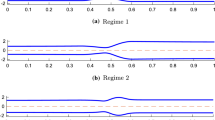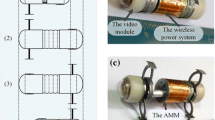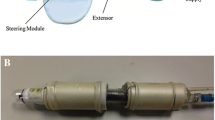Abstract
In the last years, there has been an interest in development of simulators to reproduce the mechanical properties of the human digestive system. Particularly, there have been some approaches in the development of esophagus simulators. Such simulators intend to replicate the peristaltic wave conditions, but the reported experiments are related to indirect measurements in which the use of a fluid is not reported. In this work, an X-ray technique for visualizing the flow of bolus through an artificial esophageal simulator (AES) is proposed. For that purpose, particles of barium sulfate were thoroughly mixed with baby food, in order to create a suspension used as bolus. Barium sulfate particles used in the present work are insoluble in water with non-regular forms, a size distribution from 20 to 80 nm, and a specific surface area ranging from 10 to 50 m2/g. The advantage of using barium sulfate is its high absorption of X-rays, which allows obtaining a good contrast in radiographies, so that the transport of the bolus along the esophagus simulator can be easily tracked. The results revealed the appearance of secondary flows on the wave sides, which displace as the wave contracts. This was verified with the flow fields, in which it was observed that the bolus flows mainly along the central part of the wave and a small volume tends to retract. This confirms that the flow is extensional as the bolus is stretched and compressed during the peristalsis.
Graphical abstract








Similar content being viewed by others
References
Bardan E, Kern M, Arndorfer RC et al (2006) Effect of aging on bolus kinematics during the pharyngeal phase of swallowing. Am J Physiol Gastrointest Liver Physiol 290:G458–G465. https://doi.org/10.1152/ajpgi.00541.2004
Bhattacharya D, J V AliS, LK Cheng, W Xu (2020) RoSE A Robotic Soft Esophagus for Endoprosthetic Stent Testing. Soft Robot. https://doi.org/10.1089/soro.2019.0205:
Chen X, Zhong W, Heindel TJ (2019) Orientation of cylindrical particles in a fluidized bed based on stereo X-ray particle tracking velocimetry (XPTV). Chem Eng Sci 203:104–112. https://doi.org/10.1016/j.ces.2019.03.067
Cohen RJ, Paskalev K, Litwin S et al (2010) Esophageal motion during radiotherapy: quantification and margin implications. Dis Esophagus 23:473–479. https://doi.org/10.1111/j.1442-2050.2009.01037.x
Dirven S, Xu W, Cheng LK (2015) Sinusoidal Peristaltic Waves in Soft Actuator for Mimicry of Esophageal Swallowing. IEEE/ASME Trans Mechatron 20:1331–1337. https://doi.org/10.1109/TMECH.2014.2337291
Erath BD, Hemsing FS (2016) Esophageal aerodynamics in an idealized experimental model of tracheoesophageal speech. Exp Fluids 57:34. https://doi.org/10.1007/s00348-015-2111-7
Fujiso Y, Perrin N, van der Giessen J et al (2018) Swall-E: A robotic in-vitro simulation of human swallowing. PLoS ONE 13:e0208193. https://doi.org/10.1371/journal.pone.0208193
Hasegawa A, Otoguro A, Kumagai H, Nakazawa F (2005) Velocity of Swallowed Gel Food in the Pharynx by Ultrasonic Method. Nippon Shokuhin Kagaku Kogaku Kaishi 52:441–447. https://doi.org/10.3136/nskkk.52.441
Heindel TJ, Gray JN, Jensen TC (2008) An X-ray system for visualizing fluid flows. Flow Meas Instrum 19:67–78. https://doi.org/10.1016/j.flowmeasinst.2007.09.003
Kertzscher U, Seeger A, Affeld K et al (2004) X-ray based particle tracking velocimetry–a measurement technique for multi-phase flows and flows without optical access. Flow Meas Instrum 15:199–206. https://doi.org/10.1016/j.flowmeasinst.2004.04.001
Kingston TA, Geick TA, Robinson TR, Heindel TJ (2015) Characterizing 3D granular flow structures in a double screw mixer using X-ray particle tracking velocimetry. Powder Technol 278:211–222. https://doi.org/10.1016/j.powtec.2015.02.061
Kingston TA, Morgan TB, Geick TA et al (2014) A cone-beam compensated back-projection algorithm for X-ray particle tracking velocimetry. Flow Meas Instrum 39:64–75. https://doi.org/10.1016/j.flowmeasinst.2014.06.002
Kou W, Carlson DA, Patankar NA, Kahrilas PJ, Pandolfino JE (2020) Four-dimensional impedance manometry derived from esophageal high-resolution impedance-manometry studies: a novel analysis paradigm. Ther Adv Gastroenter. https://doi.org/10.1177/1756284820969050
Lee SJ, Kim S (2005) Simultaneous measurement of size and velocity of microbubbles moving in an opaque tube using an X-ray particle tracking velocimetry technique. Exp Fluids 39:492–497
Maevsky V, Watson TJ (2011) Anatomy of the esophagus. In: Shields TW, LoCicero J, Reed CE, Feins RH (eds) General Thoracic Surgery, 7th edn. Wolters Kluwer, Philadelphia, pp 4485–4505
Peghini PL, Pursnani KG, Gideon MR et al (1998) Proximal and distal esophageal contractions have similar manometric features. Am J Physiol 274:G325–G330. https://doi.org/10.1152/ajpgi.1998.274.2.G325
Qazi WM, Ekberg O, Wiklund J, Kotze R, Stading M (2019) Assessment of the Food-Swallowing Process Using Bolus Visualisation and Manometry Simultaneously in a Device that Models Human Swallowing. Dysphagia 34(6):821–833. https://doi.org/10.1007/s00455-019-09995-8
Salinas-Vázquez M, Vicente W, Brito-de la Fuente E, Gallegos C, Márquez J, Ascanio G (2014) Early numerical studies on the peristaltic flow through the pharynx. J Texture Stud 45(2):155–163
Seeger A, Affeld K, Goubergrits L et al (2001) X-ray-based assessment of the three-dimensional velocity of the liquid phase in a bubble column. Exp Fluids 31:193–201. https://doi.org/10.1007/s003480100273
Stading M, Waqas MQ, Holmberg F et al (2019) A Device that Models Human Swallowing. Dysphagia 34:615–626
Tanaka T, Oda M, Nishimura S et al (2014) The use of high-speed, continuous, T2-weighted magnetic resonance sequences and saline for the evaluation of swallowing. Oral Surg Oral Med Oral Pathol Oral Radiol 118:490–496. https://doi.org/10.1016/j.oooo.2014.05.014
Tanaka T, Tanaka R, Yeung AWK, Bornstein MM, Nishimura S, Oda M, Habu M, Takahashi O, Yoshiga D, Sago T, Miyamoto I, Kodama M, Wakasugi-Sato N, Matsumoto-Takeda S, Joujima T, Miyamura Y, Morimoto Y (2020) Real-time evaluation of swallowing in patients with oral cancers by using cine-magnetic resonance imaging based on T2-weighted sequences. Oral Surg Oral Med Oral Pathol Oral Radiol 130(5):583–592. https://doi.org/10.1016/j.oooo.2020.05.009
Zhu M, Xu W, Cheng LK (2017) Esophageal Peristaltic Control of a Soft-Bodied Swallowing Robot by the Central Pattern Generator. IEEE/ASME Trans Mechatron 22:91–98. https://doi.org/10.1109/TMECH.2016.2609465
Acknowledgements
The financial support from DGAPA-UNAM through the grants IN-113319 and PE113019 is highly appreciated. This work has been also financed by CONACYT LN-232719, LN-271897, LN 280867, LN294415, LN 299129 and INFR-294752 grants and by the RVO 68378297 of the Czech Acad Sci. Authors also thank to M.Sc. Karen Pérez-Salas for the rheological measurements of the working fluid, and Marcos Velázquez for his support in the manufacturing of some components required for this work.
Author information
Authors and Affiliations
Corresponding author
Additional information
Publisher's Note
Springer Nature remains neutral with regard to jurisdictional claims in published maps and institutional affiliations.
Rights and permissions
About this article
Cite this article
Ruiz-Huerta, L., Palacios-Morales, C., Caballero-Ruiz, A. et al. X-ray technique for visualization of the bolus flow through an esophageal simulator. J Vis 24, 761–769 (2021). https://doi.org/10.1007/s12650-021-00743-5
Received:
Revised:
Accepted:
Published:
Issue Date:
DOI: https://doi.org/10.1007/s12650-021-00743-5




